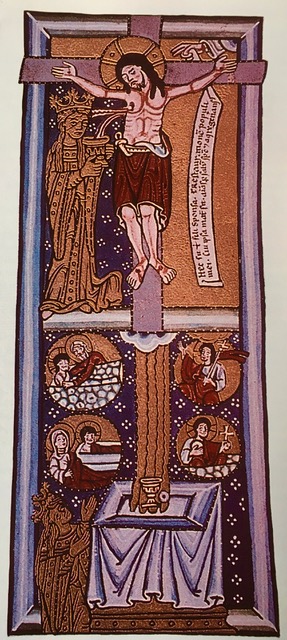Today’s Word from Trinity Keyboardist Sheila Weidendorf…
Hildegard of Bingen (von Bingen) was born in 1098 in a village on a tributary of the Rhine River (called Beckelheim or Bermersheim—sources disagree). She was the youngest of ten children born to noble parents, her father having been a knight. She was one of four children whose lives were in some way carried out within the Church. According to Barbara Newman, author of “Sister of Wisdom: St. Hildegard’s Theology of the Feminine” (1987, University of California Press), Hildegard’s parents “dedicated her to God as a tithe,” an evidently common practice of the time.
In 1106—at the age of eight—Hildegard entered a hermitage run by the Benedectine monastery of Mount St. Disibode, named after a Celtic monk famous in the region. There she was educated by the anchoress Jutta and, later, by Volmar, a Benedictine monk who eventually became her personal secretary. While still in her teens, she took the veil. Much later, at the age of 38, Jutta died and Hildegard was named her successor and thereby became anchoress of the hermitage. Three years later, she received her prophetic call or what Matthew Fox called in his 1985 publication, “Illuminations of Hildegard of Bingen,” (1985, Bear & Co. Press) her “spiritual awakening.” It was at this time that her “career” began in earnest as a prolific author and composer which drew considerable attention.
Hildegard had received visions from early childhood, but only later confided them to Jutta—who relayed them to Volmar, who reported them to the influential abbot (now Saint) Bernard of Clairvaux, by whose connections her visions were ultimately relayed to Pope Eugenius III. So it happened that she received ecclesial endorsement to record her visionary and mystical experiences. Between her sacred calling in 1141 and her death in 1179, she wrote three texts of visionary accounts and commentary, several volumes of medical encyclopedias, gynecology and pharmacology (she was a renowned herbalist sought out by many for help with their ailments which kept the monastery’s coffers full! Whenever she received any sort of restrictions on her actions from the abbot in charge, Hildegard would magically take ill and to her bed. The pilgrims and their money would cease flowing and the restrictions would be thereby magically lifted!). She also wrote meditative and mystic poetry, a multitude of vocal compositions, and what is now considered to the be the earliest recorded example of liturgical drama in the Western world—her “Ordo Virtutum.”
She was an acclaimed abbess and a reformer who largely focused her ecclesial work on the abuses of the priestly office. With backing from the Pope and a few earthly emperors as well, Hildegard traveled four times through Germany and France on speaking/preaching tours, often calling for clerical reforms. Matthew Fox—in his Preface to Gabriele Uhlein’s “Meditations With Hildegard of Bingen,” (1983, Bear & Co. Press), called her a true “renaissance woman… a musician and poet, dramatist and physicist, doctor and prophet, painter and leader of people…”
To understand her music, we must be reminded of her historical musical context. She lived in the Middle Ages, in which music was not an embellishment to worship but in itself a religious experience. Music and spirituality were inseparable in medieval sacred music, both connecting humankind with divine reality and reflecting and participating in that reality. “The experience of music can be represented as a mysterious thing… and as a metaphor for the ineffable states of mystic contemplation” (from John Stevens 1986 “Words and Music in the Middle Ages: Song, Narrative, Dance & Drama, 1050-1350,” Cambridge University Press). Music not only induces mystical experience but is itself a component of that experience. Even the performance of music was more a mystical experience for the singer than a provision of religious diversion for the listener.
The primary form of vocal sacred music was plainchant (also known as plainsong or Gregorian chant)—a melismatic, fluid, mostly step-wise melodic and unaccompanied music intended to turn the mind and spirit toward God. Says Stevens, “ideally the singers were to allow their activity to absorb the whole spirit and body, inducing a state of meditative calm and so intensifying the quality of devotional life.” Music, in its mystical dimensions of devotion and praise, was the “bridge between the order of the cosmos and the order of humanity” (Leonie Rosenstiel, ed 1982, “Schirmer History of Music,” pub. Schirmer Books”.
Thus music linked humanity to divinity, and reflected the divine cosmological order. Music revealed divine truth and created the bridge for humanity to reflect and participate in that truth. Music was considered such a strong bond or bridge that the 6th century music theorist Boethius considered human beings to be “linked with audible sound by a type of sympathetic vibration.” We are thus resonant beings created and living in a resonant universe, one with God.
Hildegard von Bingen’s music both reflected the music norms of her time AND yet departed. Her music was ecstatic and she often disregarded the “rules” of intervals, taking unheard-of leaps between notes to indicate a kind of character or inner state. To introduce you to her and to her mystic music, I have chosen her “O victoriosissimi triumphatores,” a piece written for Eastertide.
O victoriosissimi triumphatores,
qui in effusione sanguinis vestri salutantes
edificationem ecclesie,
intrastis sanguinem Agni,
epulantes cum vitulo occiso:
O quam magnam mercedem habetis,
quia corpora vestra viventes despexistis,
imitantes Agnum Dei,
ornantes penam eius,
in qua vos introduxit
in restaurationem hereditatis.
O victors in your triumph!
Your blood poured out, you hail
the building of the Church
for you have entered in the Lamb’s own blood,
and now enjoy the feast with the slaughtered calf.
How great is your reward!
Your living bodies you’ve despised
in imitation of God’s Lamb
his pain you take as glory,
for through it he has brought you
to your inheritance restored!
I am including here a NON-traditional performance of this piece—it includes unusual instrumental additions but I find it very beautiful. Find the music HERE. I am also including one of her illuminated visions (her visions were rendered by her secretary, Volmar) called The Crucifixion and the Mass.
(I invite you to take a closer look at the works and writings of Hildegard von Bingen. Her writings talk much about the “Greening” of the Earth, and her mystical musings explore the natural world as part and parcel of the experience of the holy. She was quite influenced by the lushness of the Rhine Valley of her youth and is perhaps reminiscent of the beautiful “Greening” and blooming we are currently experiencing here at Eastertide on our lovely island.)
Sheila



